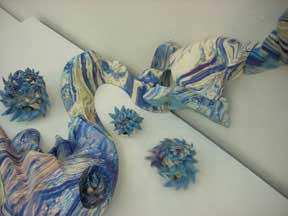
Incorporating Technology into Interactive Art
Brining life and vitality into artificial environments and life forms requires finding a way to create movement or some form of change. One way to vitalize sculptures and installations is to use computer-based technology. Computer technology allows me to incorporate various functional components into my work that can interact in response to motion, touch, or ambient sound. These techniques can potentially change the way we conceptualize and ultimately experience Digital Art. Computational technology can involve, for instance, placing microphones and motors on a sculpture that allows it to move in response to external sound. As another example, my installation titled ‘Boundaries in Nature’ consists of sound interactive kinetic components. Viewers can tactilely interact with the sculpture, which contains a musical instrument function that can create several different types of tones. The viewer can then observe the effects of their actions on the sculpture—actions that result in ripple motions and various changes in shape.
Sound Interactive Kinetic Sculpture
'Boundaries in Nature' 2009
Materials: Rapid Prototyped gypsum powder. wood, motors, metal, plaster, light sensors, epoxy, and a microphone.
Programs: Arduino and pure data.
Processes: Designed using Rhinoceros software, printed or manufactured using a 3D Color Printer. Each unit module is connected to a servo motor and rotated as the viewer’s voices is detected by a microphone.